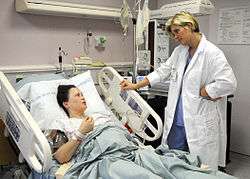Certified nurse midwife
|
US Navy CNM checks on a mother | |
| Occupation | |
|---|---|
| Names |
|
Occupation type | Specialty |
Activity sectors | nurse midwifery |
| Description | |
Education required | |
In the United States, a certified nurse midwife (CNM) is an advanced practice registered nurse in nurse midwifery, the nursing care of women during pregnancy and the postpartum period. Certified nurse midwives are exceptionally recognized by the International Confederation of Midwives as a type of midwives in the United States.[1][2]
Education and training
The American College of Nurse-Midwives accredits certified nurse-midwifery education programs and serves as the national specialty society for the nation's CNMs. CNMs in most states are required to
- possess a minimum of a graduate degree, such as the Master of Science in Nursing or a Doctorate of Nursing Practice.
- pass the NCLEX examination to become a registered nurse.
- pass the American Midwifery Certification Board exams.
- hold an active registered nurse license in the state in which they practice.
- keep up to date on latest medical knowledge as pertains to their field.[3]
In 2010 the first wave of CNMs graduated from Doctor of Nursing Practice (DNP) programs. The American College of Nurse-Midwives (ACNM) estimates that soon, one in ten babies in the U.S. will be delivered by CNMs. In 2010 the first DNP program available for CNMs graduated its first class.
Practice
CNMs function as primary healthcare providers for women and most often provide medical care for relatively healthy women, whose health and births are considered uncomplicated and not "high risk," as well as their neonates. Often, women with high risk pregnancies can receive the benefits of nurse midwifery care from a CNM in collaboration with a physician. CNMs may work closely or in collaboration, with an obstetrician & gynecologist, who provides consultation and/or assistance to patients who develop complications or have complex medical histories or disease(s).
CNMs practice in hospitals and private practice medical clinics and may also deliver babies in birthing centers and attend at-home births. Some work with academic institutions as professors.[4] They are able to prescribe medications, treatments, medical devices, therapeutic and diagnostic measures. CNMs are able to provide medical care to women from puberty through menopause, including care for their newborn (neonatology), antepartum, intrapartum, postpartum and nonsurgical gynecological care.[5][6] In some cases, CNMs may also provide care to the male partner, in areas of sexually transmitted diseases and reproductive health, of their female patients. In the United States, fewer than 1% of nurse midwives are men.[7]
See also
- Obstetrical nursing
- Mary Breckinridge Founder of Frontier Nursing Service
- Nursing
- Nurse practitioner
- Childbirth
- Doula
References
- ↑ "Become a midwife". American College of Nurse-Midwives. Retrieved 2015. Check date values in:
|access-date=(help) - ↑ "Midwives Associations Worldwide". International Confederation of Midwives. Retrieved 2015. Check date values in:
|access-date=(help) - ↑ "Exploring the Spectrum". Maryville University St. Louis Online Nurse Practitioner Programs. Retrieved 24 September 2014.
- ↑ "The Role of a Certified Nurse Midwife". University of Cincinnati Online Master of Science in Nursing.
- ↑ "18.4. Midwife practice guidelines.". The Pennsylvania Code. Retrieved 24 September 2014.
- ↑ http://www.pacode.com/secure/data/049/chapter18/s18.4.html[]
- ↑ Pilkenton, Deanna; Schorn, Mavis N (February 2008). "Midwifery: A career for men in nursing". Men In Nursing.
